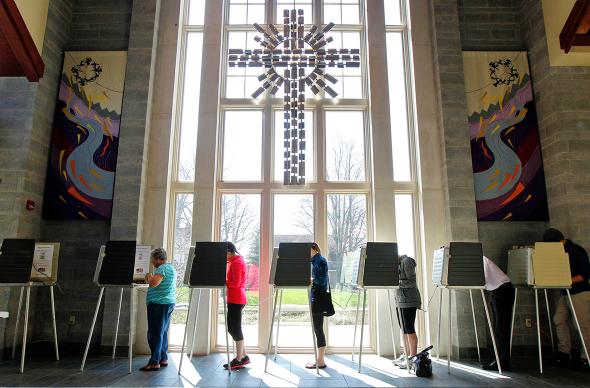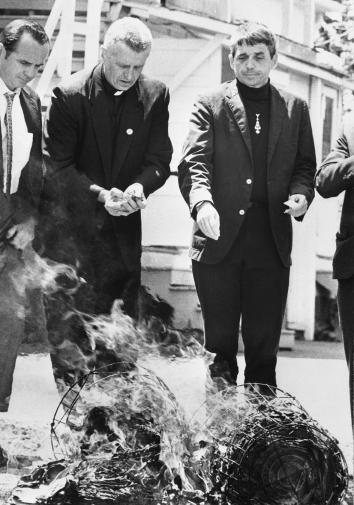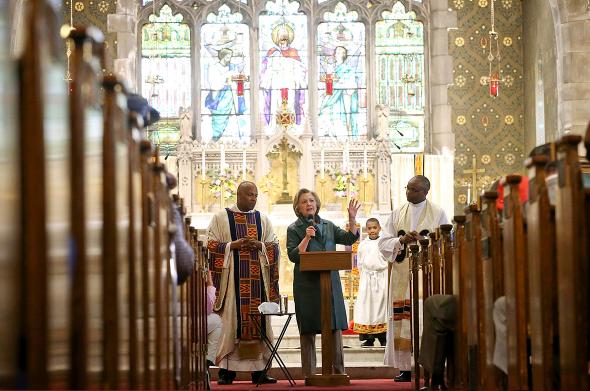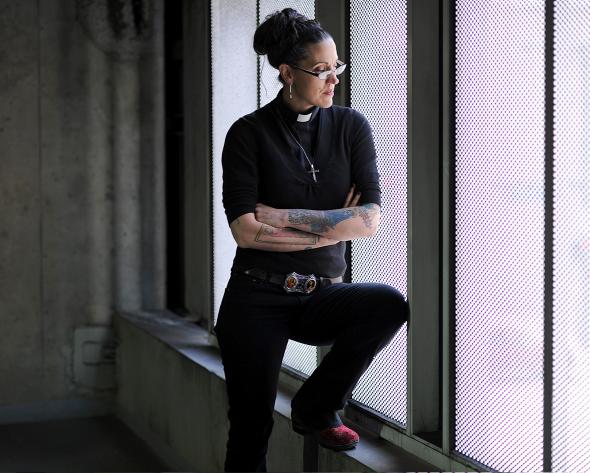Can the Christian Left Be a Real Political Force?
Trump’s rise has thrown the religious right into turmoil. How Democrats could become the party of God.

John Sommers II/Getty Images
In late November of 1973, about 50 evangelical leaders convened at a shabby YMCA hotel in Chicago for what they hoped would be a generation-defining gathering. Attendees at the Thanksgiving Workshop of Evangelical Social Concern got to work assembling a document that would serve as a manifesto for the future of their movement. They condemned institutionalized racism, unfettered capitalism, and the Vietnam War, and they proclaimed that “God lays total claim upon the lives of his people.” The stakes were high, and they knew it. “For better or for worse,” activist Ron Sider predicted, American evangelicals “will exercise the dominant religious influence in the next decade.”
As we now know, Sider was right—just not exactly as he hoped. A few years later, Baptist pastor Jerry Falwell and other leaders began to coalesce around a right-wing political agenda very different from the one laid out at the Thanksgiving Workshop. Since then, conservative evangelicals have dominated election narratives and policy battles and prompted cultural skirmishes over things like Kim Davis’ visit with the pope. If you read only the headlines on religion in America, it would be easy to assume that Christians are a unified mob of anti-gay, anti-government caricatures—as President Obama uncharitably put it back in 2008, those clinging to their guns or their religion.
Look closer, however, and conservative evangelicalism is showing serious cracks, particularly as a political movement. Its leaders are in crisis mode over the candidacy of Donald Trump, with some begrudgingly supporting him as their best hope against Hillary Clinton and others deriding him as an immoral charlatan. Marriage equality is the law of the land, and the big new issue for conservatives is religious liberty, which presumes a subservient status for Christians—the onetime “moral majority” as a minority group requiring special protection. The future of conservative evangelicalism as the dominant expression of American Christianity looks dubious, if not doomed.
The cracking apart of evangelicalism’s influence is more than the end of an era. It’s an opportunity—for Democrats picturing a broad victory in November, yes, and for Republicans who think their party needs reinvention. But it’s also an opening for another “silent majority” within American society: liberal Christians, a term that for a generation has been relegated to an oxymoron. That Christian belief can coexist with, let alone support, left-leaning social and political views has so disappeared from living rooms and community halls that any public embrace of the idea elicits surprise. At a January campaign stop in Iowa, lifelong Methodist Hillary Clinton stirred up the blogosphere with a lengthy response to a question about what the Ten Commandments mean to her:
My study of the Bible, my many conversations with people of faith, has led me to believe the most important commandment is to love the Lord with all your might and to love your neighbor as yourself. … But I do believe that in many areas judgment should be left to God, that being more open, tolerant, and respectful is part of what makes me humble about my faith, and I am in awe of people who truly turn the other cheek all the time, who can go that extra mile that we are called to go, who keep finding ways to forgive and move on.
Clinton’s “But ... ” captures the tension that animates liberal Christianity and the policy approaches that tend to flow from it. It’s important to follow God’s Old Testament orders but to leave many final judgments to him; to “love the Lord” but with humility; to do justice but to “forgive and move on.” Implicit in that simple “but” is a subtle critique of the religious right, a movement whose public expressions are seen by the left as judgmental, narrow, and punitive—more “eye for an eye” than “turn the other cheek.”
British theologian Steve Holmes has summed it up more concisely: Liberal Christianity is “Christianity that is acutely alive to the challenges to belief coming from modern philosophy”—from experience as it is lived. As Clinton’s words indicate, this translates to a religious expression less focused on theological purity and more focused on social reform, or to put it another way, more interested in Earth now than in heaven later. Whether or not you interpret this as a triumph or a disgrace probably says something about where you fall on the theological spectrum, if you’re on it at all. It’s important to note that liberal Christianity and progressive politics don’t overlap perfectly—the evangelicals at the Thanksgiving Workshop in 1973 specifically pushed back against a watered-down theology by repeatedly referencing the “Lord Jesus Christ”—but they are allied closely enough that their futures are clearly entangled.
Liberal Christians today can be found in those who use Jesus’ inspiration to advocate for criminal justice reform, in feminists who view him as a disrupter of the patriarchy, and in the everyday churchgoers who see their values better reflected by the economic and social agenda of the mainstream left. They are mainline Protestants, Catholics, and evangelicals. And if they are ever going to reinsert themselves into the heartbeat of American culture, this just might be their moment.
* * *
It’s easy to forget, but the religious left was not always so dramatic an underdog. The early 20th-century Social Gospel movement put Protestant Christians at the forefront of activism on public health, labor, and wealth inequality—and offered a religious justification for action. That movement was led by people such as Washington Gladden, a Congregationalist minister who agitated for workers’ right to organize, and Walter Rauschenbusch, a Baptist pastor who saw Jesus as proclaiming “withering woes against the dominant class.” Starting with 1928, Norman Thomas was the presidential candidate of the Socialist Party of America for six consecutive elections, and he was also a Presbyterian minister.
By the 1960s, more than half of the U.S. population belonged to a mainline Protestant church, an informal group of denominations (Lutheran, Methodist, Presbyterian among them) that had come to represent establishment liberalism. This doesn’t mean all American Christians signed up for a progressive agenda, but it was an era in which it was perfectly normal to be both mainstream left and mainline Protestant.

Bettmann/Getty Images
Liberal religiosity flourished outside the mainline tradition as well. The Second Vatican Council from 1962 to 1965 seemed to refresh the Catholic Church for a radical new era; nuns ditched the habit for jeans, parishes replaced the Latin Mass with English, and a new spirit of ecumenical openness prevailed. Activist priests Daniel and Philip Berrigan made national headlines by burning draft cards and damaging missile warheads, often while wearing their clerical collars. As the New York Times put it after Daniel Berrigan’s recent death, the brothers embodied a progressively religious claim that “that racism and poverty, militarism and capitalist greed were interconnected pieces of the same big problem: an unjust society.”
At the same time, evangelical communities were also seeing a progressive flowering. As historian David Swartz documents in his 2012 book Moral Minority: The Evangelical Left in an Age of Conservatism, a coterie of young evangelicals drew inspiration from the New Left, banding loosely together against war, repressive racial and gender politics, and economic policies that left the poor behind. Publications such as the Post-American and Right On spread this message to thousands of eager subscribers. Groups such as Evangelicals for McGovern earned sustained media attention, and some observers began to worry that mainstream evangelical organizations were becoming, as Swartz quotes from the journal Christianity and Crisis, a “haven for Democrats, minorities, and pacifists.” In the decade leading up to the mid-1970s, a time when Southern conservatives were defecting en masse to the Republican Party, Democratic identification among evangelicals actually ticked up by 4 percentage points. By the time of the Thanksgiving Workshop in 1973, the Washington Post announced the lefty gathering as “a religious movement that could shake both political and religious life in America.”
It was not to last. Swartz reports in depressing detail on how the evangelical left soon splintered along gender, racial, and denominational lines. Divisions laid bare at the Thanksgiving Workshop, where female attendees were among those who complained about not being taken seriously, only deepened in the ensuing years. Seemingly every subgroup—women, blacks, pacifists, Anabaptists, and so on—formed their own organizations with their own agendas, tactics, and vocabularies.
Then there was the issue of abortion, which continues to divide the church’s left wing, while it binds the right together with a righteous fervor. By the 1980s, evangelicals borrowed from Catholicism to promote the idea of a “seamless garment” that linked abortion with the death penalty, nuclear disarmament, assisted suicide, poverty, and other “life” issues. “Life has become cheap at the Pentagon and in abortion clinics, at the headquarters of large corporations and in pornographic movie houses, at missile silos and genetic research laboratories,” the progressive evangelical organization Sojourners lamented to supporters. But the broader progressive movement was becoming as firmly pro-choice as the Christian right was anti-abortion, leaving anti-abortion Christian progressives without a home in either camp.
Meanwhile, the mainline was having trouble navigating the roiling seas of its own postwar boom. The ecumenical instinct to merge and form sprawling national coalitions stripped away denominational distinctiveness—the sense that it mattered whether one was Presbyterian or Lutheran, let alone American Lutheran or Evangelical Lutheran or United Evangelical Lutheran. As Methodist theologian Stanley Hauerwas remarked to Newsweek of the mainline’s precipitous decline, “God is killing mainline Protestantism in America, and we goddam well deserve it.” That was in 1993, and the United Methodist Church alone has lost about 1.5 million members since then.
The same thing has happened to other historic bastions of liberal Christianity. According to Pew, the number of adults who belong to a mainline Protestant church dropped from 41 million in 2007 to 36 million in 2014. A progressive political agenda does not make a church popular: The Episcopal Church, which consecrated its first openly gay bishop in 2003 and has embraced women in leadership, saw Sunday church attendance drop 23 percent between 2000 and 2010. Even the Catholic Church, which has long nurtured a strain of social activism and accommodated progressive adherents in the pews, has seen Mass attendance steadily plummet across the board.
But despite these declines, to call American Christians a “dying breed” would be an overreach by any measure. Seventy-one percent of Americans still call themselves Christian. And meanwhile, as Pew reported last year, the number of evangelicals in the U.S. is growing; evangelicals are making new converts, nearly all of them conservative, and holding onto the believers they have. In other words, if there is to be a resurgent Christian left, it will need to learn a trick or two from the very movement that overtook it a generation ago.
* * *

Justin Sullivan/Getty Images
How might such a comeback happen? It must first be said that despite the empty pews, there’s reason to believe that liberal Christianity has been dormant, not dead. In the 2014 midterm election, 4 in 10 voters who said they attended church every week voted Democratic. No Christian denomination’s membership is more than 64 percent Republican, whereas Unitarian Universalists and several historically black denominations boast more than 80 percent Democrats. A 2013 report from the Public Religion Research Institute found that 19 percent of all Americans could be categorized as “religious progressives”: those who are theologically, socially, and economically liberal.
But the problem for the Christian left, and the reason those numbers may sound surprisingly high, is that liberal Christians often proclaim their politics not through Christianity but in spite of it. They talk about their faith apologetically, or as if their very existence will blow your mind: “Yes, I’m a Christian. No, I’m Not Like That,” as a recent essay in Huffington Post put it. Witness, too, the (sometimes overwrought) subgenre of essays on the difficulty of “coming out” as a Christian in liberal circles. At the same time, aggressively anti-religion books by New Atheists are consistent best-sellers (see: Dawkins, Richard). The norm on the left is now to be politically and socially progressive and have nothing to do with the church. But how would liberal Christianity look different today if it asserted itself more forcefully, if more Christians explained their progressive politics not as separate from their faith, but because of it?
There are plenty of ambassadors out there to point the way, and they don’t all need the pulpit to make their case. One of the two liberal (or at least conservative-skewering) lions of comedy late night for the past decade has been Stephen Colbert, who in interviews has never been shy about his relationship with God. (“I am here to know God, love God, serve God, that we might be happy with each other in this world and with Him in the next,” he’s said.) Web-savvy writers such as “Jesus feminist” Sarah Bessey and Rachel Held Evans have staked out possible middle paths between the trenches of the culture wars, providing hope for a liberal reconciliation nearly given up as impossible. In 2013 Evans wrote a long blog post indicting the rigid dogmas of both the pro-choice and pro-life movements and argued persuasively for Christians to “advocate for life in a way that takes seriously the complexities involved and that honors both women and their unborn children.” There’s also a lesson to be learned from black churches, whose members maintain staunch Democratic loyalty even though they are more likely to be theologically conservative. And of course there’s Pope Francis, who some speculate could be the great white-robed hope of liberal Christianity. Even if he isn’t, the groundswell of optimism is a sign that the hunger for one exists.
If liberal Christianity is ultimately going to thrive, however, it’s hard to imagine it doing so without reviving the local churches that have been shrinking over the decades. Conservative congregations ask for serious commitment; they expect their people to show up, and they ask them to adhere to a narrower set of beliefs and behaviors. There’s a cost associated with membership. The political economist Laurence Iannaccone observed in the early 1990s that churches that ask more from their followers tend to be stronger. As an evangelical sociologist once told me, people are drawn to beliefs that make “demands of the flesh.”
Many progressive churches, by contrast, barely demand a pinky toe. Most of those I’ve attended regularly have been happy when I merely show up, in part because their populations tend to be small and elderly. They don’t pressure me when I skip; the sermons rarely suggest it matters whether I believe the creeds we recite on Sunday mornings. (The demands that small or struggling churches do make on members tend to be organizational and financial labor, so you get the draining obligations without the spiritual investment.) By contrast, when I visit conservative churches with family or friends, they feel alive: People are there because they think it matters, for their everyday lives and for their eternal souls. The 2013 Public Religion report found that only 11 percent of religious progressives say religion was the most important thing in their lives, compared with 54 percent of religious conservatives. The Christian left would benefit from Christian right’s urgency not just with politics but with religion itself.
It can happen. For several years I was a member of a decently sized mainline church in Brooklyn that did this beautifully, through sermons grounded in scripture, not just good manners, and even by holding weeknight Bible studies, an evangelical staple. I recently started attending a Congregationalist church in New Hampshire that is similarly warm and lively, with full(ish) pews and an active choir and children’s ministry. A more prominent example is House for All Sinners and Saints, a church in Denver founded by the heavily tattooed Lutheran pastor Nadia Bolz-Weber. A best-selling author and a major draw as a speaker on the Christian conference circuit, she possesses an evangelical-esque instinct for branding. Crucially, she articulates a muscular version of liberal Christianity (a label she’s resisted) that doesn’t reduce the Bible to mere metaphor or boil down its instructions to “be nice and recycle”; at the same time, one-third of her congregation is lesbian, gay, or transgender, and the church boasts a “minister of fabulousness.”

RJ Sangosti/Denver Post via Getty Images
A missing ingredient for liberal Christians, in other words, may be something that comes more naturally to many evangelicals: zeal. With Hillary Clinton all but assured to be the Democratic standard-bearer come November, the door has not been wider in decades for an activist Christian left to play an indispensable role in progressive politics. Clinton will be able to do what has been unthinkable for decades: take on her Republican counterpart from a position of faith. The Democratic presumptive nominee boasts a more convincing Christian worldview than does the Republican, who has had trouble convincing churchgoers of his theological seriousness. Many evangelical leaders say they will never vote for Trump. Russell Moore, author and public-policy leader of the Southern Baptist Convention, the largest Protestant denomination in the U.S., has been so vocal in his disdain for Trump that the mogul added him to his long list of Twitter enemies. The so-called God gap, shorthand for the longstanding Republican advantage among the religious, was just 15 points at the end of April, with weekly churchgoers preferring Trump by 9 points and less religious voters preferring Clinton by nearly 6. In 2012, the number of points separating Mitt Romney and Barack Obama was almost 40.
Since Clinton is in little danger of losing her party’s secular left wing, she has a very real—and rare—opportunity to woo religious voters. Her impromptu campaign forays into her faith could be expanded into a robust public case for the principles of liberal Christianity. She is uniquely positioned to contend that affordable health care, a higher minimum wage, and paid family leave are moral arguments at heart (borrowing from her Democratic primary rival), and to speak about them in the language of what is still the mainstream religion of the U.S.—transforming the idea of who qualifies as a “values voter” in America.
One of the reasons the Bible remains such a vital text millennia after it was compiled is that anyone can find her beliefs both confirmed and challenged within. The New Testament includes passages that seem to defend slavery, for example, and to promote the subservient status of women. But then there is Jesus, whose radical vision is for a world in which the poor, the outcast, and the struggling are triumphant in the end:
Blessed are you who are poor,
for yours is the kingdom of God.
Blessed are you who hunger now,
for you will be satisfied.
Blessed are you who weep now,
for you will laugh. ...
It’s not a political platform. But could it support one? As the religious right struggles to determine its own path forward, believers on the left have the chance to form an influential band of opposition to those who have long been the loudest voices within American Christianity. The political left may not need such a contingent to win this November, but it would be foolish not to embrace one. As the manifesto of the Thanksgiving Workshop put it back in 1973, “Although the Lord calls us to defend the social and economic rights of the poor and oppressed, we have mostly remained silent.” It would be unfair to say that liberal Christians haven’t tried to make noise. But now, 43 years later, they may have their best chance to be heard.
